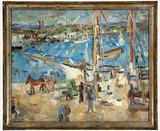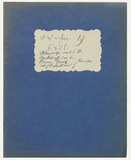Manfred Henninger
Manfred Henninger
Jetzt ist es traurig und trüb auf der Welt und man fragt sich, was tut man noch da.
[Now all is sad and gloomy in the world and one asks oneself what one is still doing here. (ed. trans.)]
Manfred Henninger in September 1936 after fleeing from Ibiza, his first port of exile
| Born | on 2 December 1894 in Backnang |
|---|---|
| Died | on 5 October 1986 in Stuttgart |
| Exile | Switzerland, Spain |
| Remigration | Federal Republic of Germany |
| Profession | Painter, Keramiker |
Manfred Henninger, who had studied under Oskar Kokoschka among others, had become an established part of the Stuttgart arts scene at the beginning of the 1930s. His figurative painting was fed by his pantheistic worldview. In March 1933, his promising career was brought to an abrupt end. Warned of his imminent seizure by the Nazis, the committed communist artist fled Germany. It was the beginning of a sixteen-year period of exile.
Henninger travelled through Switzerland and France to Spain from where he moved with his family (which had since joined him) to Ibiza. Throughout his life the artist was fascinated by landscapes and the motif of bathers; he painted hundreds of pictures there. In autumn 1936, the family left the island in fear of the approaching Spanish Civil War. Henninger travelled on to Switzerland alone. His then heavily pregnant wife and sons went to Germany and did not follow him permanently to his exile in Ticino until 1940. Before then, the artist had experienced years of loneliness, and also of serious illness, during which he never ceased painting, reading about ancient mythology and writing creatively, all of which gave him sustenance.
Soon after the war ended, Henninger applied from exile in Switzerland for a job in Germany and was appointed in late 1949 to the Kunstakademie in Stuttgart. His four decades of work following his remigration, including numerous drawings, are profoundly marked by the forced years of exile. This is evident e.g. in the continuation of his ceramic work.
Selection of important works:
Landschaft bei Hermance (1933)
Bauernhof in Ibiza mit Palme (1936)
Kastanienbäume (1937)
Paul Sabanga (1943)
Verscio im Winter (1948)
Further reading:
Hoffmann, Monika (Red.): Manfred Henninger. Retrospektive 1919-1984. Malerei aus der Farbe, Berlin: Staatliche Kunsthalle 1984.
Galerie der Stadt Kornwestheim (Hrsg.): Sammlung Manfred Henninger. Mit Beiträgen von Arnold und Peter Henninger, Jens Kräubig und Barbara Strieder, Kornwestheim 1991.







